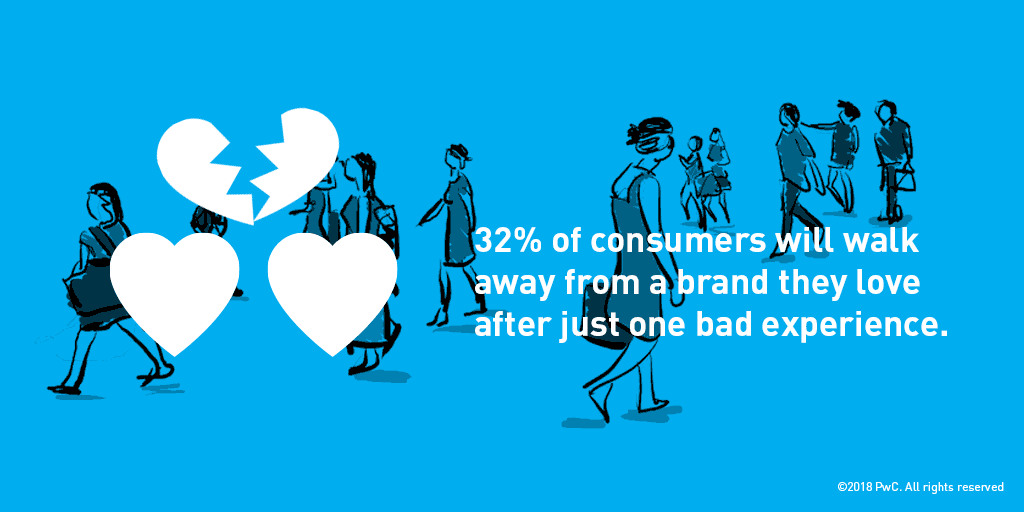Today’s Retail Needs Both Tech and the Human Touch
Digital tools can enhance the customer experience, but won’t replace people.
Retail has become synonymous with digital bells and whistles. Artificial intelligence is helping retailers detect patterns and predict customer preferences, augmented reality enables customers to try on clothes or test out room decor, and “scan and go” apps are changing the way shoppers pay. But even as technology has enhanced the shopping experience, consumers are often coming away unsatisfied. Call it an experience disconnect: Companies tout their latest digital innovation, but fail to focus on the aspects of customer experience that are the most meaningful.
Findings from a recent PwC Consumer Intelligence Series (CIS) survey of 15,000 global consumers confirm what we’ve observed in countless shopper–retailer interactions: The human touch still matters. Seventy-five percent of survey respondents report that they want more human interaction in the future, not less. Further, nearly three-quarters of shoppers say customer experience is more important than price and product quality when it comes to purchasing decisions; 65 percent of U.S. consumers say a positive experience with a brand is more influential than advertising, even advertising they consider “great.”


These numbers should serve as a wake-up call to retailers as they consider how best to engage with shoppers. Technology will remain central to retailers’ ability to understand and predict customer behavior. But none of these high-tech capabilities would be possible without people. Whether on the front lines or behind the scenes, it takes a veritable army of specialized staff — floor associates, data scientists, product designers, artificial intelligence experts, supply chain specialists, distribution center workers, and more, all operating in concert with technology — to delight customers with products and services they didn’t even know they wanted and keep them coming back. Stories of a retail apocalypse notwithstanding, this is a time of revival and reinvention for retailers able and willing to deliver the experience that customers increasingly demand. Here are three ways they can start.
Inspire a community of commerce. Innovative retailers understand the imperative to create a welcoming environment where shoppers enjoy spending their time as much as their money. Liberated from being just an inventory repository, today’s reimagined store is a community of commerce — an outlet for product discovery, a forum to educate and entertain, and a channel to reinforce the brand. And the opportunity for stores to transform is ripe: In PwC’s 2018 Global Consumer Insights Survey, 44 percent of shoppers reported visiting a physical store at least weekly, up from 42 percent in 2012.
In April 2018, traditional retailer Nordstrom opened a Manhattan boutique catering solely to men. Customers can have their shoes shined and meet with a tailor for custom alterations, and can virtually try on clothes using a digital avatar. The retailer is also breaking new ground with Nordstrom Local, its new concept for women. The small boutique does not carry inventory for immediate purchase but has items available for shoppers to try on. They can then buy online or order merchandise for in-store or curbside pickup. To promote a sense of community, the store also boasts shopper-friendly amenities such as personal stylists and on-site alterations, as well as a cocktail bar and nail salon.
Some companies that started as online pure plays are also finding that physical stores are a critical way to build in-person connections with customers. This omnichannel experience makes good business sense, considering that online sales still represent just 10 percent of core retail sales. Even Amazon is blurring the lines between online and offline retail with the launch of its first Amazon Go in Seattle — a cashier-less grocery store, but one with employees on site to help troubleshoot, locate items, and prepare meals for purchase.
Warby Parker, which started selling its reasonably priced, direct-to-consumer eyeglasses as an online-only brand in 2010, now has more than 60 boutiques across the U.S. and aggressive plans for more. Other online upstarts, such as mattress company Casper and socially conscious clothes brand Everlane, have recently opened physical stores to enable shoppers to interact with their products in person.
Create a culture that empowers employees. Even as technology plays a larger role, the most successful retailers understand that employees are the connective tissue in the retail experience. The risk of not getting the human element right is significant: PwC’s CIS survey found that 56 percent of shoppers will turn away from their favorite products or brands after several bad experiences, and 32 percent will walk after just one bad experience. Meanwhile, 53 percent of respondents to PwC’s Global Consumer Insights study reported that interaction with knowledgeable, helpful salespeople gave them the most satisfaction as shoppers — a higher percentage than those who named technology-enabled experiences such as personalized offers or in-store screens that display an extended range of products.
Some companies have taken the need for excellent service to heart. The Ritz-Carlton, for example, empowers each employee to spend as much as US$2,000 per guest to provide superior service, and encourages employees to use their creativity to ensure every customer experience is memorable. That relentless focus on the customer works: The Ritz-Carlton has received numerous prestigious hospitality awards for guest satisfaction and has among the highest employee retention rates in an industry notorious for employee attrition.
Another company whose core values are infused throughout the customer experience is outdoor equipment retailer REI. REI’s culture encourages employees to embrace the sporting lifestyle and share their experiences with customers. Employees get two extra days off each year to participate in outdoor and wellness-related activities. REI also closes its doors on Black Friday, encouraging employees get into nature instead. This strategy has translated into deeper customer engagement, with millions of customers participating in REI’s #OptOutside movement.
Recruit a data-literate workforce. Being in the retail business today means being in the data business. Customer experience falls short if retailers can’t effectively harness the power of technology in order to engage customers. Retailers need data scientists and other professionals with advanced analytics skills who can help companies carry out analyses and apply data to better understand customers and predict trends.
Analysis from a 2017 report by PwC and the Business-Higher Education Forum finds that retail has the highest proportion of job openings for data-driven decision makers. And retail is in the top three industries seeking functional analysts. By 2021, employer demand for data science and analytics skills will far exceed supply. To fulfill current and future needs, savvy retailers are rethinking the talent pipeline and doing more outreach to identify, develop, and recruit retail workers with in-demand skills.
To aid in this effort, some trade groups are implementing programs that prepare workers for tomorrow’s retail environment. One such program run by the NRF Foundation, the philanthropic arm of the National Retail Federation (of which one of the authors is the president, and another is on the board) offers college students — with majors as diverse as merchandising, economics, and computer engineering — an opportunity to explore retail career paths spanning the entirety of the retail ecosystem, including supply chain, logistics, marketing, finance, and technology. Elsewhere, UpSkill America, a coalition of businesses that promotes retraining, partners with retailers to reskill and upskill employees in areas such as marketing analytics, user experience, and software development.
Ultimately, the human element remains central to customer interactions, even if it’s embedded within automation, artificial intelligence, advanced analytics, or other technologies. The premiums shoppers are willing to pay — as well as the value of their loyalty — add up for companies who heed the call for a customer experience that hinges on human connection.
Author profiles:
- Steve Barr is a partner with PwC US, based in San Francisco. He is the PwC US retail and consumer markets leader, and is a member of the board of directors of the National Retail Federation (NRF) Foundation.
- Ellen Davis is senior vice president of research and strategic initiatives at the National Retail Federation and president of the NRF Foundation.



